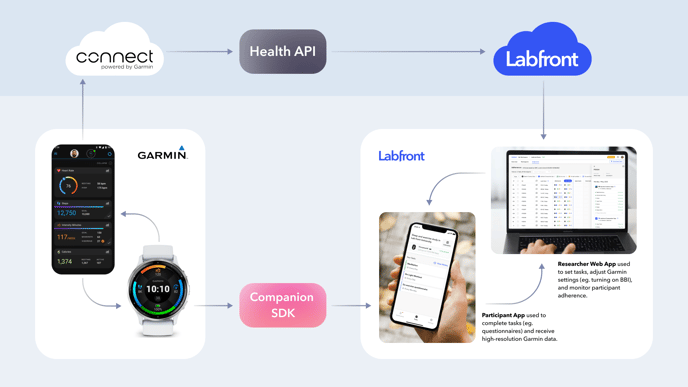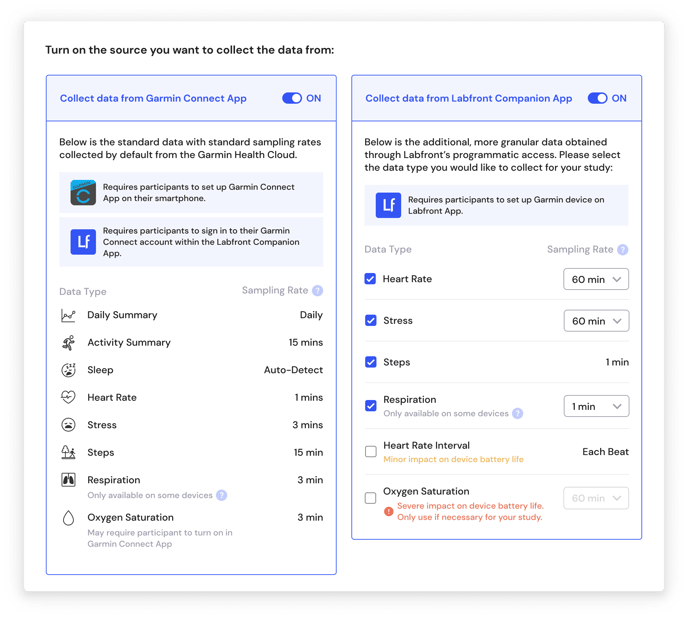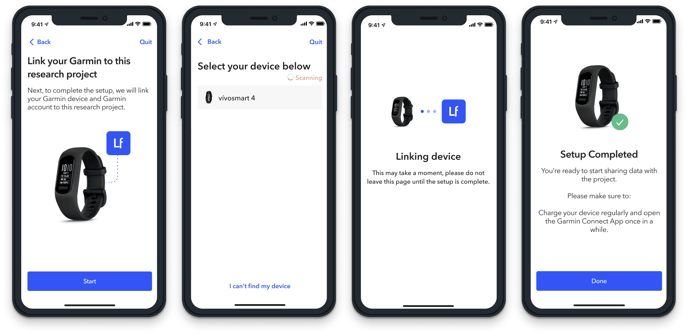Garmin Overview
Why should you consider using Garmin wearables in your research? How do they work with Labfront? This article provides a thorough overview of everything Garmin for researchers.
Table of Contents
|
1. About Garmin
Since the early 2000s, Garmin has been producing wrist wearables and has established itself as a trusted industry leader. Your research goals will be easier to achieve with products that support researchers across all disciplines, whether you need sleep staging, body composition, respiration rate, blood pressure, oxygen saturation, or granular interbeat interval data.
1.1 Use Cases
- Dissect how sleep and sedentary habits affect mental health
- Track the efficacy of a certain intervention with more context data
- Study the effectiveness of a new medication for hypertension by tracking changes in blood pressure over several weeks or months.
- Track the impact of environmental factors such as air pollution or noise exposure on blood pressure.
- Examine the effectiveness of a weight loss program by tracking changes in not just weight but overall body composition over time.
- Monitor the impact of a particular medication on muscle mass in patients with a chronic illness.
Note
Garmin's Third-Party Studies Database has many examples of how Garmin devices are being used in research. Check it out→
1.2 Published Studies
Garmin devices are being used in research to measure steps, heart rate, sleep, and more. Garmin's Health Research Database has a comprehensive collection of 1000+ published third-party studies using Garmin devices.
1.3 Buying Devices
While we don't currently provide the option to purchase Garmin devices from us directly, we do offer an exclusive discount on Garmin devices to Labfront customers. The amount of discount depends on the device type and quantity, but it is usually ~20%. Get in touch with us at hello@labfront.com if you're interested in taking advantage of this offer.
Recommendation
For the most affordable and compact device, we suggest using the Garmin vívosmart 5. If you’d like a bigger display, longer battery life, and more sensors, then we recommend using the Garmin Venu® 3.
2. Using Garmin Devices with Labfront

2.1 Researchers
To capture physiological data from Garmin devices, simply add a Garmin device to your Labfront project and choose the data source you want to use to collect data.
.png?width=688&height=446&name=Add%20Devices%20(1).png)

2.2 Participants
Participants will set up the device on the Labfront app in a few easy steps once they join the project.
Then they will wear the device and open the Labfront app regularly to sync and upload their data.

Learn more about the participant experience→
2.3 Case Studies
- Physiotherapy and Cystic Fibrosis Study
- Frontline Healthcare Worker Resiliency Study
- Physical Activity and Teens with T1D
- Stanford WELL for Life Wearable Pilot Study
3. Garmin Data
3.1 Data Types
Here is an overview of the types of data you can collect using Garmin devices. The data types and sampling rates will vary depending on which source is used for data collection--Garmin Connect, Labfront Companion, or both.
%20(1).png?width=688&height=688&name=Data%20Source%20Comparison%20Chart%20(2000%20x%202000%20px)%20(1).png)
Learn more about Garmin data sources and how they impact participant experience→
3.2 Data Format
Learn how Labfront conveniently separates and organizes data into CSV files in this Data Overview article.
4. Garmin Resources
For additional information on Garmin Health and Garmin wearables, we recommended taking a look at the following resources:
- Garmin Health
- Garmin Health 3rd Party Studies
- Garmin Health SDK Overview
- Garmin Health Blog
- Garmin Wearables
- Garmin Wearables Wear and Care Tips
5. FAQs
Is there a specific Garmin wearable device recommended to use with Labfront?
For the most affordable and compact device, we suggest using the Garmin vívosmart 5. If you’d like a bigger display, longer battery life, and more sensors, then we recommend using the Garmin Venu® series.
How accurate are Garmin devices for measuring heart rate, Sp02, or other physiological data?
Garmin devices have been used successfully for physiological data collection across many different types of research projects, including clinical trials. As with any wearable sensor, the quality of data collection depends on the amount of extra signal noise. Device fit, device usage, and motion intensity all affect the resulting accuracy.
- Visit this page for tips and advice about getting the best performance for heart rate accuracy.
- For details about pulse ox and heart rate accuracy, please read this information.
- For further tips about getting the best performance out of your Garmin device, please visit Garmin Support.
What are some best practices to help optimize for accuracy from Garmin wearables?
Many factors may affect the accuracy of your wearable device for measuring physiological data, including the device fit and level of activity/motion. For this reason, we recommend the following tips:
- Fit matters: Make sure all participants know how to correctly wear said wearable device.
- More samples, more insights: Collect extra samples and average them to get more accurate representations.
- Less movement, higher accuracy: Try to take measurements during low activity periods when possible, such as when one is sitting at a desk or sleeping.
Is Labfront compatible with non-Garmin devices?
Yes, Labfront is compatible with Dexcom CGMs as well as Movesense devices for IMU/ECG data. The latest list of compatible devices is available on our website. We do update this list from time to time, so if you are interested in a specific device that is not listed on the website, then please reach out to hello@labfront.com
🔎 Can't find the answer you're looking for?
Check out our top FAQs or get in touch at support@labfront.com.